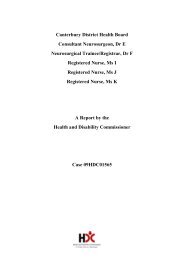Gisborne Hospital Report - Health and Disability Commissioner
Gisborne Hospital Report - Health and Disability Commissioner
Gisborne Hospital Report - Health and Disability Commissioner
You also want an ePaper? Increase the reach of your titles
YUMPU automatically turns print PDFs into web optimized ePapers that Google loves.
<strong>Gisborne</strong> <strong>Hospital</strong> 1999 – 2000<br />
Operating Theatre Protocols<br />
3.24 It transpired that technical <strong>and</strong> nursing staff felt that there was a conflict of<br />
interest in THL’s own investigation into the re-use of syringe incidents being<br />
carried out by the acting Medical Director <strong>and</strong> the Group Manager (<strong>Hospital</strong>).<br />
3.25 As a result of the THL June 2000 inquiry, <strong>and</strong> advice received by THL, a<br />
“look back” programme was put in place. Patients considered at risk were<br />
contacted <strong>and</strong> advised to see their general practitioners.<br />
3.26 The draft report from the acting Medical Director (I was not provided with a<br />
final report) stated:<br />
“There is no debate that syringes were re-used in the first two to three<br />
weeks of Dr L’s locum. No written information allows a more precise<br />
estimate of the critical time period. While trying not to re-use in the<br />
period thereafter, Dr L acknowledges that a 20+ year habit does not go<br />
overnight, <strong>and</strong> that he cannot exclude a further use thereafter.”<br />
3.27 The report contained a section on the Relevant Infectious Diseases:<br />
“The key infectious diseases to consider are hepatitis B <strong>and</strong> C <strong>and</strong> HIV<br />
(human immuno-deficiency virus, the causative agent of AIDS –<br />
acquired immuno-deficiency syndrome).<br />
The three are all transmitted through blood products <strong>and</strong> other body<br />
fluids. Hepatitis B is the most easily transmitted of the three diseases.<br />
Viral load in an infectious person is high, <strong>and</strong> the infective dose (in<br />
terms of amount of body fluid) is very small. While the other two are<br />
infectious, their degree of infectivity from small inoculations of blood is<br />
far less. The transmission of hepatitis B through needle-stick injury is<br />
well recognised: indeed, it is an occupational hazard for health workers.<br />
While there is evidence of spread of HIV through needle stick, the risks<br />
are of an order of magnitude less.<br />
The prevalence of hepatitis B is higher in Tairawhiti in general, in<br />
particular Maori <strong>and</strong> Asian populations. While HIV is prevalent in New<br />
Zeal<strong>and</strong>, Tairawhiti is a low prevalence (though not zero) area. The<br />
prevalence of hepatitis C is thought to be low.<br />
Hepatitis B is, therefore, by far the most infectious of the diseases under<br />
consideration. The local prevalence increases one aspect of the risk of<br />
syringe re-use. To become infected there has to be the following chain.<br />
Firstly, a preceding patient has to be infectious for the disease<br />
concerned. Secondly, there has to be transfer of sufficient viral particles<br />
for infection, thirdly, the host patient has to be receptive, that is, nonimmune.<br />
Patients were possibly exposed to an infection risk through the transfer<br />
of virus particles from one patient’s blood or serum to another’s through<br />
the re-use of a contaminated syringe.<br />
78
















